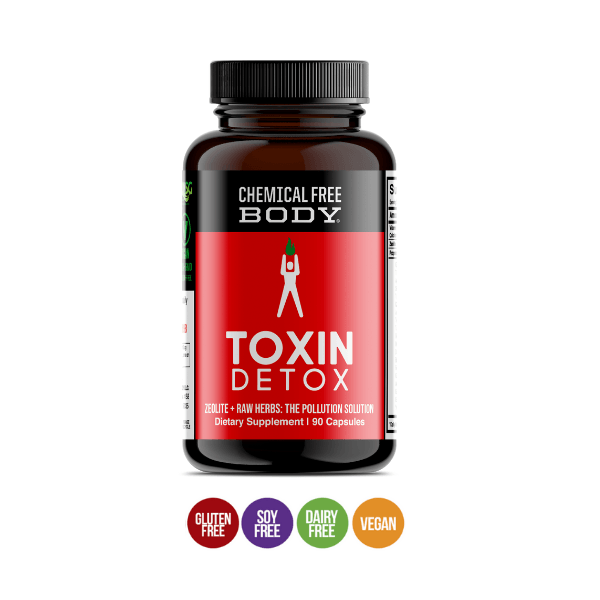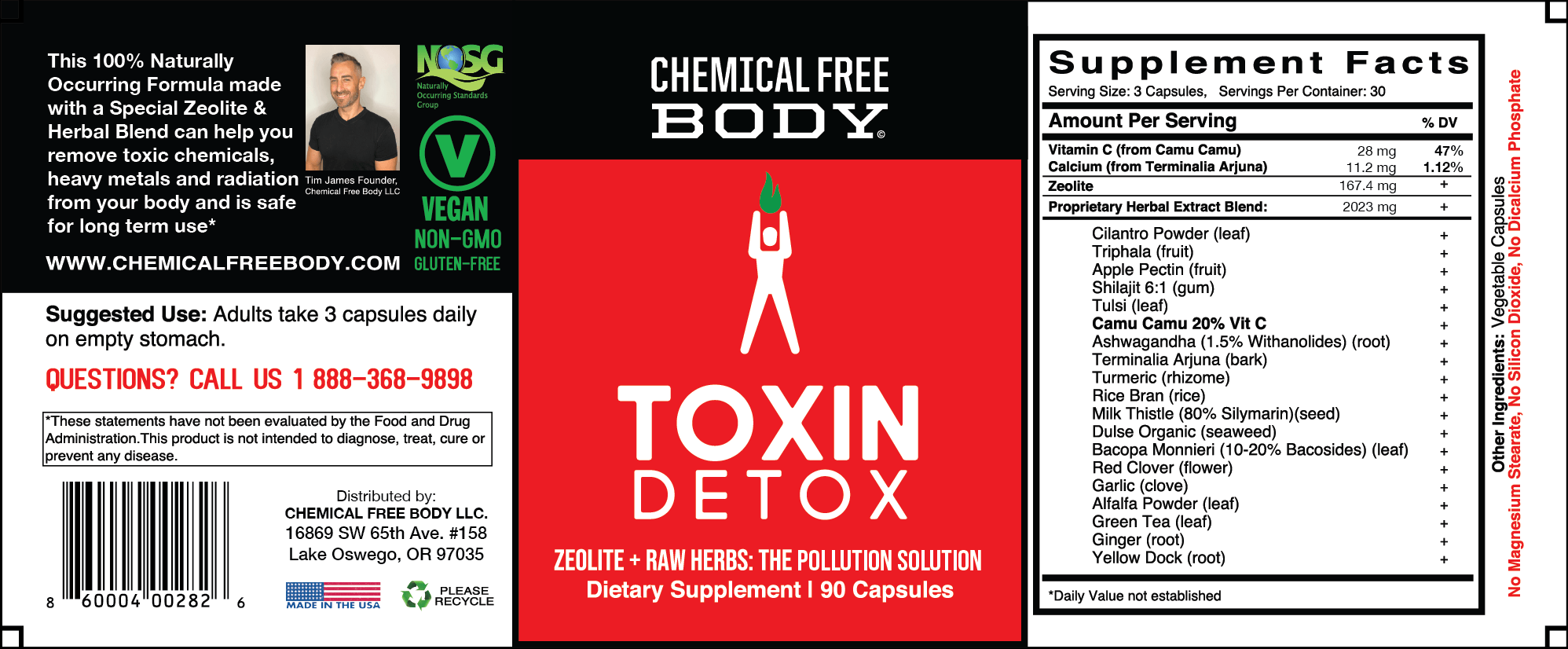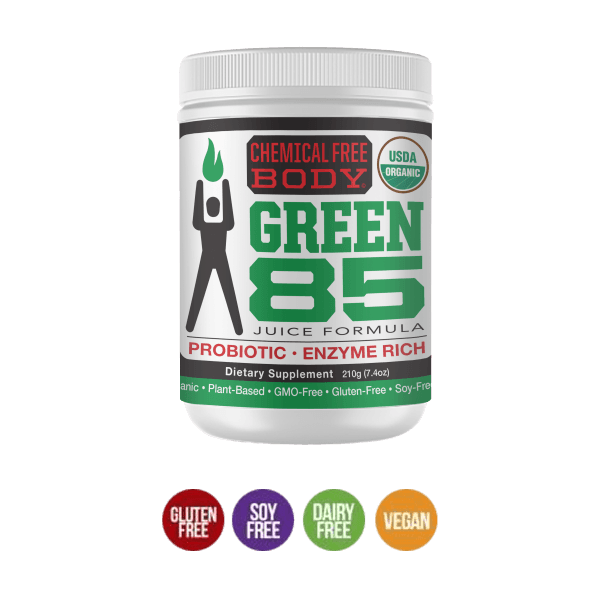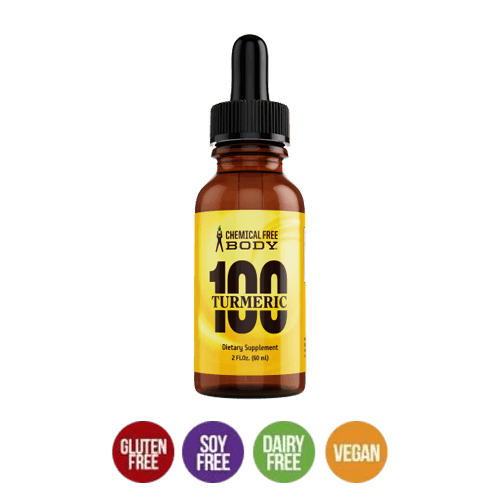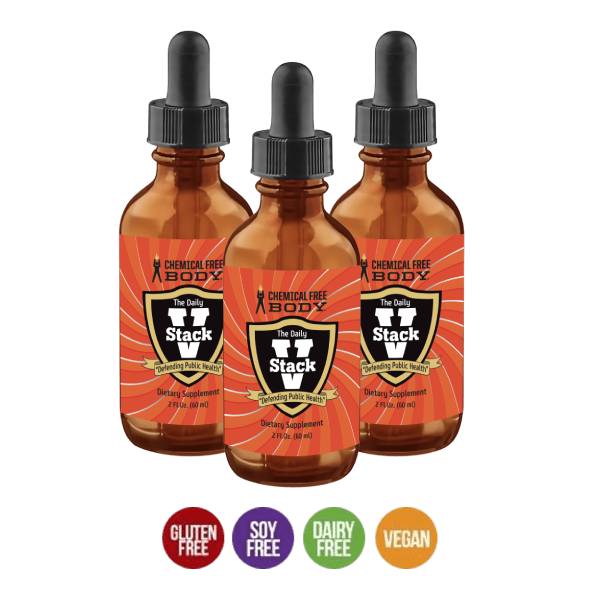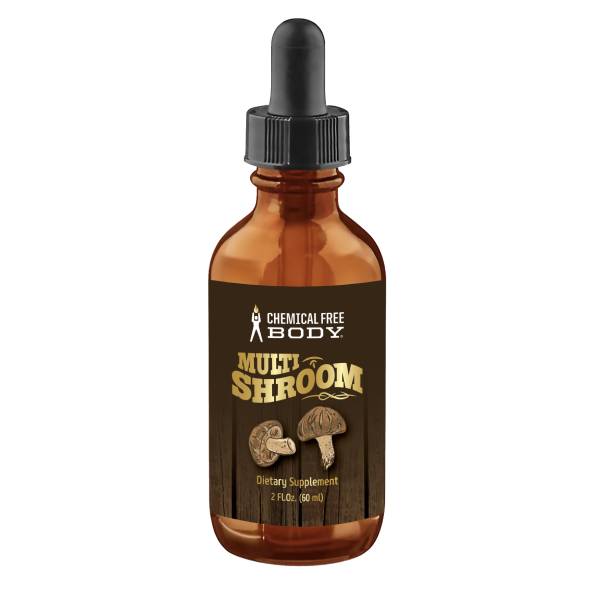
Description
Why do we need to detox daily? Toxic chemicals and heavy metals have polluted our ecosystem contributing to the major rise in public health issues.
Since 2005 scientists have found over 250 toxic cancer-causing and brain-disrupting chemicals in the umbilical cord blood of newborns and the older we are the more time for those toxins to accumulate in the body. This 100% naturally occurring formula is made with special, heavy metal-free Zeolites and a powerful Herbal Blend that can support your body’s natural elimination of toxic Chemicals, Heavy Metals, Radiation, Synthetic Estrogens, and Free-Radicals.
Toxin Detox is THE POLLUTION SOLUTION! This is your daily defense against the microscopic bad guys!
Science
TOXIN DETOX FORMULA (The Science)
Ingredients : Gentle detoxer for heavy metals, radiation & toxins
ZEOLITE
Zeolite has been purported to have a wide variety of health benefits including acting as a chelator to help remove heavy metals from the body, improve liver function, balance biological pH levels, improve general well-being, control allergies and asthma, improve digestion and act as an antioxidant.
Large amounts of research have been done on all the possible benefits of detoxing with Zeolite and studies show that they appear to balance pH within the body, reduce allergies, act as antioxidants, and aid liver function. Zeolites also appear to help with digestion and also help to remove toxic heavy metals from the body.
Whenever there is a nuclear disaster, such as the one at Fukushima, truckloads of Zeolite are dumped at the site and used to “absorb” and “capture” the radioactive particles as part of the cleanup operations.
Zeolite was discovered to assist in removing toxic metal toxins through urination without depleting the body’s store of essential electrolytes.
A study published in the journal “Nutrition and Dietary Supplements,” tested the chelation potential of natural zeolite. The researchers concluded that the Zeolite “represents a potentially safe and effective way to remove (chelate) toxic heavy metals from the body through increased urinary excretion without removing clinically detrimental amounts of vital electrolytes.”
The FDA has put Zeolite on its GRAS (Generally Recognized As Safe) list. High grade Zeolite for human consumption must be non-synthetic from natural mined sources and purified and specially washed of impurities before use as a supplement. [1-4]
APPLE PECTIN
Fruit pectin is effective for removing contaminants from the body such as heavy metals and other toxins. Detoxifying the body from heavy metals and contaminants optimizes health and allows the body to repair itself.
In one study following the Chernobyl accident, two groups of children, one with very high and another with less high levels of cesium 137 were given supplementary apple pectin. Apple pectin significantly decreased 137Cs loads in these groups (39% and 28%, respectively).
Modified citrus pectin 15 g/day significantly increased the urinary excretion of arsenic, cadmium, and lead in healthy adults (normal metal load) after 6 days of administration. This chelating effect has been attributed to the presence of rhamnogalacturonan in pectin. In children from Belarus with moderate and high cesium loads, the administration of apple-derived pectin ( Vitapect ) 10 g/day reduced the level of cesium. Beneficial effects on the antioxidant level of hematologic systems have also been demonstrated. [5-9]
SHILAJIT
Shilajit is a traditional herbal remedy that has been used for chelation of heavy metals and as an antioxidant and rejuvenator. It is also used to support elimination organs like the kidneys and liver. Known historically as the “Destroyer of Weakness”, Shilajit has naturally occurring Fulvic Acid and Humic Acid to help support general immune health.
In traditional medicine Shilajit is considered a panacea herbal remedy since it has so many positive benefits for supporting good health, strengthening and general vitality. [9-15]
TULSI
Tulsi or Holy Basil is a traditional herb that has been revered for thousands of years as the “The Incomparable One” and was traditionally used to promote a positive stress response and the elevation of the spirit. Basil is also known to support anti-microbial and detox action. [16-17]
ASHWAGANDHA
Ashwagandha is a traditional herb known for its adaptogenic qualities. As a powerful adaptogen, Ashwagandha increases an individual’s ability to adapt to environmental stresses and factors and helps to reduce damage to the body from these factors. It helps the body to maintain a balanced state while under physical stress and supports balancing the stress of detoxification. [18-25]
DULSE
Dulse sea lettuce is naturally high in trace minerals, iron and iodine.
Dulse has been clinically proven to possess free radical scavenging activity, making dulse useful as an antioxidant and detox agent. The combination of constant stress, environmental pathogens, and malnutrition is harming many people’s immune systems. Utilizing dulse and other antioxidants helps to repair compromised body tissues. [25-28]
BACOPA
Bacopa monnieri is a traditional herb used to support brain functions including memory, focus, concentration and cognitive activity.
Studies indicate that Bacopa can dilate the brain blood vessels which may support the removal of brain toxins. [29]
RICE BRAN
Rice bran is useful for detoxification. Rice bran fiber (RBF) has also been shown to have a high binding ability with PCBs and other toxins, including the combustion byproduct benzo(a)pyrene in a laboratory setting. [30-34]
RED CLOVER
Red Clover is a traditional herb well known in the Native American pharmacopeia. Red clover is known as a blood purifier for detox. [35-39]
TRIPHALA
Triphala or “three fruits” is a combination of the myrobalan family of fruits commonly eaten in Asia. Triphala is a traditional remedy for deep digestive cleansing and balancing and one of the most important traditional herbal formulas for efficient digestive functioning. [40-42]
YELLOW DOCK
Yellow dock supports liver detoxification. Adding detox-supportive herbs like yellow dock can assist an under-functioning liver get rid of toxins, waste products, and excess hormones.
According to the Botanical Safety Handbook: 2nd Edition, Safety Class 1A adaptogens, like Yellow dock can be described as: “Herbs that can be safely consumed when used appropriately.”
Evaluations of the antioxidant potential of yellow dock root have confirmed it to reduce oxidative stress. A study by the Department of Chemistry at Jamia Hamdard in India showed yellow dock root to possess potent antioxidant activity; working to scavenge for free radicals and thwart oxidative damage, including in liver tissue. [43-47]
MILK THISTLE
Milk thistle is a natural herb traditionally use as an antioxidant and anti-inflammatory and for detoxification
As an antioxidant, milk thistle is equally powerful to other important nutrients like vitamin E or vitamin C, which help fight free radical damage and slow the aging process that can lead to disease development. It specifically contains high levels of lipophilic extracts from the seeds of the plant, which act as bioflavanoid antioxidants that increase immunity and slow down oxidative stress.
While it has many different benefits, milk thistle is most well-known for its support of liver health and as a liver detoxifier. The liver constantly works hard to help defend us from toxins that are common in our everyday life, acting like a filter and removing harmful substances from the body.
Milk thistle is shown to decrease, or even reverse, damage to the liver that’s been caused by prescription medications, antibiotics, pollution and heavy metals.
The seeds and leaves of the milk thistle plant can be consumed either in pill, powder, tincture, extract or tea form. The seeds can actually be eaten completely raw too, but usually people prefer to take a milk thistle extract or supplement in order to consume a higher dose and see bigger results.
Milk thistle gets its name from the milky-white liquid that runs off of the plant’s leaves when they’re crushed. The actual leaves of the plant also have a spotted white pattern that makes them look as if they’ve been dunked in milk.
- Liver Detoxification & Health
As a liver support and liver aid, milk thistle is a powerful detoxifier. It helps rebuild liver cells while removing toxins from the body that are processed through the liver. Milk thistle is effective at naturally reversing the harmful effects of alcohol consumption, pesticides in our food supply, heavy metals in our water supply, pollution in the air that we breathe in and even poisons!
The liver is actually our largest internal organ and is responsible for performing a number of essential detoxifying functions. The condition of our blood throughout our whole body is mostly reliant on the health of our liver. As a “blood purifier,” the liver needs to actively clean the blood each and every day in order to support nearly every system within our body.
The liver helps remove harmful substances from our blood, aids in hormone production, detoxifies the body, releases glucose into the bloodstream in order to give our body steady energy and releases bile into our small intestine so fat can be absorbed from foods. You can see why poor liver function can create so many problems!
Milk thistle has been approved as a therapeutic treatment for various liver diseases, including fatty liver syndrome, damage from alcoholism, jaundice, psoriasis, hepatitis and others. (3)
- Helps Protect Against Cancer
Milk thistle seeds are a high source of the antioxidant flavonoid called silymarin. Silymarin is associated with decreasing the risk for cancer development by boosting the immune system, fighting DNA damage and reversing cancerous tumor growth.
In 2007, after reviewing numerous studies involving milk thistle therapeutic treatments, researchers at the University of Minnesota found that:
“There is strong preclinical evidence for silymarin’s hepatoprotective and anticarcinogenic effects, including inhibition of cancer cell growth in human prostate, skin, breast, and cervical cells.” (4)
About 50 percent to 70 percent of the silymarin molecules present within milk thistle are the type called silybin. This antioxidant stimulates protein synthesis and changes the outside layer of healthy cells, keeping them protected from damage and mutation. It inhibits toxins from dwelling in the body; helps with cell renewal; and counteracts the harmful effects of pollutants, chemicals and heavy metals that can cause “free radical damage.”
Silymarin acts as a cancer protector because it’s “a toxin blockade agent” and inhibits binding of toxins to the cell membrane receptors, according to researchers at the University Magna Graecia Department of Experimental and Clinical Medicine. (5)
- Can Help Lower Inflammation
The U.S. National Library of Medicine considers milk thistle to be a powerful anti-inflammatory, stopping inflammation, which is one of the main causes of heart disease. Milk thistle benefits heart health and helps lower high cholesterol levels by lowering inflammation, cleaning the blood and preventing oxidative stress damage within the arteries.
Although more formal research is still needed, preliminary studies show that when syilymarin milk thistle extract is used in combination with other traditional treatment methods, total cholesterol, low-density lipoprotein (LDL or “bad”) cholesterol and triglycerides levels all improve compared to levels before taking milk thistle. (6)
Something important to keep in mind, however, is that existing studies on possible heart benefits of milk thistle have only been done involving people with diabetes, who tend to have high cholesterol levels. So at this time it’s unclear if milk thistle has the same effects in other people and if it will be used to naturally lower cholesterol levels in the future.
- May Help Control or Prevent Diabetes
According to National Institute of Health, there’s some compelling research showing that taking silymarin, the main chemical found in milk thistle, along with conventional treatments can help control symptoms of diabetes by helping with glycemic control. The valuable effect of antioxidants found in milk thistle has been reported in experimental and clinical studies to help decrease blood sugar levels in insulin-resistant patients.
One 2006 study conducted by the Department of Pharmacology at the Institute of Medicinal Plants found that when diabetic patients were given silymarin extract over four weeks, their fasting blood glucose and insulin levels improved significantly compared to patients receiving a placebo. (7)
This is likely true because the liver is partly responsible for regulating hormones, including the release of insulin into the bloodstream. Insulin is responsible for managing blood glucose (sugar) levels in the blood, which is especially important for those with diabetes.
- Helps Prevent Gallstones
The liver is a major digestive organ, helping process nutrients and toxins that enter our body through foods, water and air. Because the liver and other digestive organs — like the gallbladder, pancreas, intestines and kidneys — work closely together to improve liver health so much, milk thistle is also able to help prevent gallstones and kidney stones.
Milk thistle benefits help support the endocrine and gastrointestinal systems by aiding in the production of bile and enzymes, on top of helping clean the blood. Milk thistle can help purify the body of metabolic waste, thereby regulating the function of the gallbladder, in addition to the kidneys and spleen.
- Boosts Skin Health
Studies show that phytochemicals, like those found in silymarin of milk thistle, are effective at inhibiting UV light-induced oxidative stress on the skin. Milk thistle is considered to be a potent inhibitor of UV-induced oxidative stress that can cause skin diseases like skin cancer. Research also suggests that applying silymarin found in milk thistle to the skin reduces skin damage caused by radiation treatment in patients who have had treatments for cancer. (8)
In 2008, when researchers from the Department of Dermatology at the University of Alabama Birmingham compared the effects of strong UV light exposure on the skin of mice, mice who received milk thistle extract showed much less damage on the skin than the mice who did not receive milk thistle.
- Has Anti-Aging Effects
Because milk thistle’s antioxidants help prevent free radical damage throughout the body and remove pollutants and waste from the blood and digestive tract, it can actually slow the aging process. This is true on both the surface of your skin and also within your organs.
Milk thistle benefits can also reduce your risk for some of the most common and serious disorders that develop in adults as they age, including heart disease, cancer, diabetes, kidney and liver damage, aged skin, and vision-related problems.
Milk thistle’s protective qualities of the skin make it great for reducing visible signs of aging, so consuming milk thistle can be an easy way to prevent skin cancer and skin damage, such as dark spots, wrinkles, lines and discoloration. (9) The same antioxidant properties make it useful for maintaining the health of your eyes, joints and muscles. [48-51]
AMLA
Amla berries are a traditional fruit that are known to contain the highest level of naturally occurring vitamin C of any food source. Amla also contains bioflavonoids and Ellagic acid which make it one of the most powerful antioxidant sources of free-radical scavenging as related to detoxification. This allows Amla to help cleanse the blood stream and tissues of toxins that are created during normal daily functioning or after stressful activities including athletic performance. [52-58]
TERMINALIA ARJUNA
Terminalia arjuna bark is a traditional herb used historically to detoxify the blood. This happens partly due to its astringent effects.
- arjuna is also known as a heart “protector” and is used for heart muscle strengthening to prevent heart pain and bring more oxygen to the heart. [59-65]
CILANTRO
Cilantro is a culinary herb commonly used in salads and food dishes. It is known as a chelation agent for the removal of heavy metals.
In 2001, researchers in Japan decided to investigate the effects of cilantro on lead deposition. For their study, which was published in the Journal of Ethnopharmacology, the researchers administered cilantro via gastric intubation to male mice suffering from high levels of lead in their bodies. An established chelating agent, dimercaptosuccinic acid (DMSA), was used as the control.
After the 25-day trial period, the mice were checked for lead. The results showed that both the cilantro and the DMSA had “significantly decreased lead deposition in the femur and severe lead-induced injury in the kidneys.” Moreover, the cilantro increased the urinary excretion of delta-aminolevulinic acid (ALA), which is known to increase with lead intake. The researchers concluded that cilantro contained substances that had a suppressive effect on lead deposition.
Another study published in Acupuncture & Electrotherapeutics Research found that cilantro could help chelate mercury and aluminum, as well as lead, from the body.
Since heavy metals are excreted in the urine, Dr. Omura began testing his patients’ urine. When one patient exhibited increased levels of mercury in his urine after consuming a meal containing cilantro, the doctor began to test the herb for its possible chelating properties. He found that the cilantro accelerated the removal of the heavy metals from his patients’ bodies, allowing the antibiotics to eliminate the infections for good.
In a follow-up study published one year later, Dr. Omura investigated the effects of cilantro on a patient that suffered from build-ups of mercury in the lungs, liver, kidneys, and heart after having three mercury-based amalgam fillings removed. After a few weeks of regular cilantro consumption, the levels of mercury had significantly decreased.[66-68]
TURMERIC
Turmeric has proven chelating activities for aluminum, cadmium, chromium, copper, lead and mercury. This chelating property of turmeric can be useful in preventing accumulation of heavy metals in body tissues.
Scientific evidence regarding role of turmeric which naturally contains the active, curcumin, in Aluminium toxicity:
A study was conducted to investigate the protective effect of curcumin against aluminium toxicity.
Aluminium chloride at a dose of 100mg/kg was administered daily for 6 weeks. This was accompanied with curcumin treatment at a dose of 30 or 60mg/kg per day for 6 weeks.
Various tests were performed to ascertain the level of oxidative damage and the effect of aluminium on memory and locomotion.
Aluminium treatment reduced memory retention, caused significant oxidative damage, reduced signal transmission through neurons and accumulated to toxic levels in the tissues.
Chronic curcumin administration attenuated the alterations brought about by aluminium and reduced aluminium concentrations.
Results suggested that curcumin can protect against aluminium induced cognitive dysfunction and this can be relevant to treatment of Alzheimer’s disease.
Curcumin is proven to reduce aluminium induced oxidative stress and mitochondrial dysfunction in rat brain.
Mitochondrion is a cellular unit responsible for cellular respiration and energy supply.
Reactive oxygen species produced by mitochondria cause oxidative damage and this mechanism is linked to neurodegenerative diseases and ageing.
Curcumin at a dose of 50mg/kg was administered in conjunction with aluminium (100mg/kg) to rats for 8 weeks.
Aluminium was provided daily while curcumin treatment was provided on alternate days.
Aluminium caused oxidative damage, reduced the level of antioxidants and the activity of mitochondrial complexes in the brain tissue.
Curcumin supplementation significantly normalized the activity of the mitochondrial complexes and the level of antioxidant enzymes thereby suggesting that it demonstrates protective effects against aluminium induced neurotoxicity.
Aluminium levels in the brain tissue increases with age leading to decline in cognitive activity.
Ageing related parameters include level of antioxidant enzymes, extent of lipid peroxidation and activity of electron pumps that regulate the entry of molecules in the cell.
As a part of the experimental study, these parameters were measured in aluminium fed rats and compared with those from rats who received curcumin and aluminium concomitantly.
Aluminium was found to cause lipid peroxidation and it reduced the level of antioxidant enzymes and activity of electron pumps.
Curcumin treatment, on the other hand, normalized all the changes brought by aluminium by utilizing its antioxidant property.
Results proved that curcumin can counteract ageing-related processes that are enhanced by aluminium.
ALFALFA
Alfalfa is a traditional herb known to contain many vitamins and minerals and is used in detoxification and for the benefit of digestive issues. It can be used for re-mineralization of the body during or after a detox program. Further, the high enzyme content of the plant make it a powerful tool for enhanced digestion and assimilation of nutrients.
GARLIC
Garlic has been used for centuries as a detoxification agent.
A remarkable study published in the journal Basic & Clinical Pharmacology & Toxicology revealed something very special about garlic: it is a natural detoxifier of lead and is not only as effective as a common chelation drug known as d-penicillamine at pulling this metal out of the body but is also much safer.
The study was titled, “Comparison of therapeutic effects of garlic and d-penicillamine in patients with chronic occupational lead poisoning,” and sought to confirm previous research in animals that showed garlic (Allium sativum) is effective in reducing blood and tissue lead concentrations.[71-72]
Detoxification, or removing the “bad stuff” from the body is a key component to health and longevity. There are many foods, herbs and drugs that are in the arsenal of a holistic patient and their doctor’s tool kit to help the body detoxify in a natural manner. Garlic is one of the most important!
This ancient longevity food has so many functions that it truly ranks as one of the most important super-foods. Garlic has two major functions:
- A super detox food supporting many liver enzymes, the body’s manufacturing of glutathione and other factors critical for detoxification including multiple sulfur compounds and bio-active selenium.
- Garlic is the most effective broad spectrum anti-microbial agent possessing 39 different anti-fungal, bacterial, parasitic and viral agents.
GREEN TEA
Green Tea (Camellia sinensis) has been consumed for thousands of years and Green Tea has been shown to encourage the healthy detox of the liver and the entire body. It also offers the body antioxidant support with free-radical cleansing, and it has been studied to show support of metabolic and cardiovascular health. Green Tea has also been shown to have a slightly anabolic (muscle-building) effect in those who lift weights regularly, as well as in older adults, who naturally begin to lose muscle mass as they age.
Green tea is high in polyphenols like flavonoids and catechins, which function as powerful antioxidants that contribute to removal of toxins. These substances can reduce the formation of free radicals in the body, protecting cells from damage.
One of the more powerful compounds in green tea is the antioxidant Epigallocatechin Gallate (EGCG), which has been studied to treat various diseases and may be one of the main reasons green tea has such powerful medicinal and cleansing properties. [73-76]
GINGER
Ginger is a traditional herb used for detox. The most commonly used medicinal part of the plant is the rhizome, the root-like stem that grows underground. It’s a rich source of antioxidants including gingerols, shogaols, zingerones, and more.
Ginger has broad-spectrum antibacterial, antiviral, antioxidant, and anti-parasitic properties, to name just several of its more than 40 pharmacological actions many of which help to detox the body. [77-83]
References:
-
- Dogliotti G, Malavazos AE, Giacometti S, Solimene U, Fanelli M, Corsi MM, Dozio E. Natural zeolites chabazite/phillipsite/analcime increase blood levels of antioxidant enzymes. J Clin Biochem Nutr. 2012 May;50(3):195-8. doi: 10.3164/jcbn.11-63. Epub 2011 Nov 29.
- James L Flowers, Stewart A Lonky, Erik J Deitsch. Clinical evidence supporting the use of an activated clinoptilolite suspension as an agent to increase urinary excretion of toxic heavy metals. Dovepress Journal. 2009 November. Volume 2009:1 Pages 11 – 18 DOI: http://dx.doi.org/10.2147/NDS.S8043.
- Beltcheva M, Metcheva R, Popov N, Teodorova SE, Heredia-Rojas JA, Rodríguez-de la Fuente AO, Rodríguez-Flores LE, Topashka-Ancheva M. Modified natural clinoptilolite detoxifies small mammal’s organism loaded with lead I. Lead disposition and kinetic model for lead bioaccumulation. Biol Trace Elem Res. 2012 Jun;147(1-3):180-8. doi: 10.1007/s12011-011-9278-4. Epub 2011 Dec 7.
- G. Rodrigues-Fuentes, M.A. Barrios, A. Iraizoz, I. Perdomo, B. Cedre. Enterex: anti-diarrheic drug based on purified natural (zeolite) clinoptilolite. Elsevier Science Inc. 1997.
- G S Bandazhevskaya, V B Nesterenko, V I Babenko, T V Yerkovich, Y I Bandazhevsky Relationship between caesium (137Cs) load, cardiovascular symptoms, and source of food in ‘Chernobyl’ children — preliminary observations after intake of oral apple pectin. Institute of Radiation Safety Belrad, Minsk, Republic of Belarus. [email protected]. Swiss Med Wkly. 2004 Dec 18;134(49-50):725-9.
- Bandazhevskaya GS, Nesterenko VB, Babenko VI, Yerkovich TV, Bandazhevsky YI. Relationship between caesium (137Cs) load, cardiovascular symptoms, and source of food in ‘Chernobyl’ children—preliminary observations after intake of oral apple pectin. Swiss Med Wkly . 2004;134(49-50):725-729.
- Eliaz I, Hotchkiss AT, Fishman ML, Rode D. The effect of modified citrus pectin on urinary excretion of toxic elements. Phytother Res . 2006;20(10):859-864.
- Nesterenko VB, Nesterenko AV, Babenko VI, Yerkovich TV, Babenko IV. Reducing the 137Cs-load in the organism of “Chernobyl” children with apple-pectin. Swiss Med Wkly . 2004;134(1-2):24-27.
- Bereza VIa, Chaialo PP, Iatsula GS, Shimelis IV, Protas AF. Pectin-containing products in the dietary nutrition of subjects exposed to ionizing radiation as a result of the accident at the Chernobyl Atomic Electric Power Station [in Russian]. Lik Sprava . 1993;(8):21-24.
- Ghosal S, Reddy JP, Lal VK Shilajit I: chemical constituents . J Pharm Sci. (1976)
- Acharya SB, et al Pharmacological actions of Shilajit . Indian J Exp Biol. (1988)
- Agarwal SP, et al Shilajit: a review . Phytother Res. (2007)
- Meena H, et al Shilajit: A panacea for high-altitude problems . Int J Ayurveda Res. (2010)The need for formulation of shilajit by its isolated active constituents
- Bucci LR Selected herbals and human exercise performance . Am J Clin Nutr. (2000)
- Biswas TK, et al Clinical evaluation of spermatogenic activity of processed Shilajit in oligospermia . Andrologia. (2010)
- Hossain MA1, Kabir MJ, Salehuddin SM, Rahman SM, Das AK, Singha SK, Alam MK, Rahman A. “Antibacterial properties of essential oils and methanol extracts of sweet basil Ocimum basilicum occurring in Bangladesh”:Pharm Biol. 2010 May;48(5):504-11. doi: 10.3109/13880200903190977.
- Rattanachaikunsopon P1, Phumkhachorn P. “Antimicrobial activity of basil (Ocimum basilicum) oil against Salmonella enteritidis in vitro and in food.”: Biosci Biotechnol Biochem. 2010;74(6):1200-4. Epub 2010 Jun 7.
- Archana R, Namasivayam A. Antistressor effect of Withania somnifera. J Ethnopharmacol. 1999;64:91–93. [PubMed]
- Atta-ur-Rahman, Samina-Abbas, Dur-e-Shahwar, Jamal SA, Choudhary MI, Abbas S. New withanolides from Withania spp. Journal of Natural Products. 1991;56:1000–1006.
- Begum VH, Sadique J. Effect Of Withania-Somnifera On Glycosaminoglycan Synthesis in Carrageenin-Induced Air Pouch Granuloma. Biochemical Medicine and Metabolic Biology. 1987;38(3):272–277.[PubMed]
- Bhandari CR. Ashwagandha (Withania somnifera) “Vanaushadhi Chandroday” (An Encyclopedia of Indian Herbs) Vol. 1. Varanasi, India: CS Series of Varanasi Vidyavilas Press; 1970. pp. 96–97.
- Bhattacharya SK, Goel RK, Kaur R, Ghosal S. Anti – stress activity of Sitoindosides VII and VIII. New Acylsterylglucosides from Withania somnifera. Phytother Res. 1987;1:32–37.
- Bhattacharya SK, Kumar A, Ghosal S. Effects of glycowithanolides from Withania somnifera on animal model of Alzheimer’s disease and perturbed central cholinergic markers of cognition in rats. Phytother Res. 1995;9:110–113. Budhiraja RD, Sudhir S. Review of biological activity of withanolides. JSIR. 1987;46:488–491.
- Changhadi Govardhan Sharma, author. Ashwagandharishta – Rastantra Sar Evam Sidhyaprayog Sangrah – Krishna-Gopal Ayurveda Bhawan (Dharmarth Trust) Nagpur: 1938. pp. 743–744.
- Dekosky S, Scheff SW. Synapse loss in frontal cortex biopsies in Alzheimer’s disease: correlation with cognitive severity. Ann Neurol. 1990;27:457–464.
- “Extracts from dulse (Palmaria palmata) are effective antioxidants and inhibitors of cell proliferation in vitro.” Y.V. Yuan, et al. Food and Chemical Toxology, July 2005; 43(7):1073-81.
- “Nutritional value of proteins from edible seaweed Palmaria palmata (dulse),” A.V. Galland-Imouli, et al. The Journal of Nutritional Biochemistry, June 1999; 10(6): 353-9.
- Bauman College.org. “Hashimoto’s Autoimmune Thyroiditis: Eating for Health Applications for Recovery,” by Jody Friedlander, M.S. and Edward Bauman, M.Ed., Ph.D.
- Navneet Kumar, L. G. Abichandani, Vijay Thawani, K. J. Gharpure, M. U. R. Naidu, and G. Venkat Ramana Efficacy of Standardized Extract of Bacopa on Cognitive Functions of Medical Students: A Six-Week, Randomized Placebo-Controlled Trial.
- J Nutr 2004;134:135-42.
- Chemosphere 2005;61:374-82.
- Fukuoka Igaku Zasshi 1995;86:212-7.
- Fukuoka Igaku Zasshi 1993;84:273-81.
- Fukuoka Igaku Zasshi 2003;94:118-25.
- Gartoulla P, Han MM. Red clover extract for alleviating hot flushes in postmenopausal women: a meta-analysis. Maturitas. 2014; 79(1):58-64.
- Geller SE, Studee L. Soy and red clover for mid-life and aging. Climacteric. 2006 Aug;9(4):245-263.
- Heck AM, DeWitt BA, Lukes AL. Potential interactions between alternative therapies and warfarin. Am J Health Syst Pharm. 2000;57(13):1221-1227.
- Howes JB, Sullivan D, Lai N. The effects of dietary supplementation with isoflavones from red clover on the lipoprotein profiles of postmenopausal women with mild to moderate hypercholesterolemia. Atherosclerosis. 2000;152(1):143-147.
- Husband A. Red clover isoflavone supplements: safety and pharmacokinetics. Journal of the British Menopause Society. 2001;Supplement S1:4-7.
- PULOK K. MUKHERJEE, SUJAY RAI, SAUVIK BHATTACHARYYA, PRATIP KUMAR DEBNATH, TUHIN KANTI BISWAS, UTPALENDU JANA, SRIKANTA PANDIT, BISHNU PADA SAHA, PRADIP K. PAUL, Clinical Study of ‘Triphala’ – A Well Known Phytomedicine from India IRANIAN JOURNAL OF PHARMACOLOGY & THERAPEUTICS Copyright © 2006 by Razi Institute for Drug Research (RIDR) IJPT 5:51-54, 2006.
- Scientific validation of the ethnomedicinal properties of the Ayurvedic drug Triphala: A review. Chinese Journal of Integrative Medicine December 2012, Volume 18, Issue 12, pp 946–954.
- Pratya Phetkate, Tanawan Kummalue, Yaowalak U-pratya, and Somboon Kietinun. Significant Increase in Cytotoxic T Lymphocytes and Natural Killer Cells by Triphala: A Clinical Phase I Study. Faculty of Medicine, Thammasat University, Pathumthani 12121, Thailand.
- Maksimović Z, Kovacević N, Lakusić B, Cebović T. Antioxidant activity of yellow dock (Rumex crispus L., Polygonaceae) fruit extract. Phytother Res. 2011 Jan;25(1):101-5. doi: 10.1002/ptr.3234.
- Lone IA, Kaur G, Athar M, Alam MS. Protective effect of Rumex patientia (English Spinach) roots on ferric nitrilotriacetate (Fe-NTA) induced hepatic oxidative stress and tumor promotion response. Food Chem Toxicol. 2007 Oct;45(10):1821-9. Epub 2007 Apr 19.
- Yildirim A, Mavi A, Kara AA. Determination of antioxidant and antimicrobial activities of Rumex crispus L. extracts. J Agric Food Chem. 2001 Aug;49(8):4083-9.
- Ghosh L, Gayen JR, Sinha S, Pal S, Pal M, Saha BP. Antibacterial efficacy of Rumex nepalensis Spreng. roots. Phytother Res. 2003 May;17(5):558-9.
- Getie M, Gebre-Mariam T, Rietz R, Höhne C, Huschka C, Schmidtke M, Abate A, Neubert RH. Evaluation of the anti-microbial and anti-inflammatory activities of the medicinal plants Dodonaea viscosa, Rumex nervosus and Rumex abyssinicus. Fitoterapia. 2003 Feb;74(1-2):139-43.
- Abenavoli L, Capasso R, Milic N, Capasso F. Phytother Res. Milk thistle in liver diseases: past, present, future. 2010 Oct;24(10):1423-32. doi: 10.1002/ptr.3207.
- Phytother Res. 2006 Dec;20(12):1036-9. The efficacy of Silybum marianum (L.) Gaertn. (silymarin) in the treatment of type II diabetes: a randomized, double-blind, placebo-controlled, clinical trial.
- Photochem Photobiol. 2008; 84(2): 266–271. Published online 2007 Nov 28. doi: 10.1111/j.1751-1097.2007.00241.x
- Santosh K. Katiyar, Sreelatha Meleth4and Som D. Sharma. Silymarin, a Flavonoid from Milk Thistle (Silybum marianum L.), Inhibits UV-induced Oxidative Stress Throncbi.nlm.nih.gov/…ntrez/eutils/elink.fcgiugh Targeting Infiltrating CD11b+ Cells in Mouse Skin. Photochem Photobiol. 2008; 84(2): 266–271.
- Manjunatha S, et al Effect of Chyawanprash and vitamin C on glucose tolerance and lipoprotein profile . Indian J Physiol Pharmacol. (2001)
- Baliga MS Triphala, Ayurvedic formulation for treating and preventing cancer: a review . J Altern Complement Med. (2010)
- Vasudevan M, Parle M Effect of Anwala churna (Emblica officinalis GAERTN.): an ayurvedic preparation on memory deficit rats . Yakugaku Zasshi. (2007)
- Vasudevan M, Parle M Memory enhancing activity of Anwala churna (Emblica officinalis Gaertn.): an Ayurvedic preparation . Physiol Behav. (2007)
- Herbal medicine in ancient Egypt. Ali SK, et al In-vitro evaluation of selected Egyptian traditional herbal medicines for treatment of alzheimer disease . BMC Complement Altern Med. (2013)
- Anilakumar KR, Nagaraj NS, Santhanam K Reduction of hexachlorocyclohexane-induced oxidative stress and cytotoxicity in rat liver by Emblica officinalis gaertn . Indian J Exp Biol. (2007)
- EVALUATION OF PHYSICOCHEMICAL AND PRELIMINARY PHYTOCHEMICAL STUDIES ON THE FRUIT OF EMBLICA OFFICINALIS GAERTN Judprasong K, et al Nutrients and bioactive compounds of Thai indigenous fruits . Food Chem. (2013)
- Sasikumar Dhanarasu, Mathi Selvam, Suzan M. Abdel-Tawab Salama, Manoharan Shanmugam, and Prema Sethuraman. Terminalia Arjuna (Roxb.) Modulates Circulatory Antioxidants on 7,12-dimethylbenz(a)anthracene- induced Hamster Buccal Pouch Carcinogenesis. Oman Med J. 2010 Oct; 25(4): 276–281.
- Khaliq F, et al Terminalia arjuna Improves Cardiovascular Autonomic Neuropathy in Streptozotocin-Induced Diabetic Rats . Cardiovasc Toxicol. (2013)
- Dall’Ago P, et al Baroreflex and chemoreflex dysfunction in streptozotocin-diabetic rats . Braz J Med Biol Res. (1997)
- Parveen A, et al Terminalia arjuna enhances baroreflex sensitivity and myocardial function in isoproterenol-induced chronic heart failure rats . J Cardiovasc Pharmacol Ther. (2012)
- Parveen A, et al Mechanistic clues in the cardioprotective effect of Terminalia arjuna bark extract in isoproterenol-induced chronic heart failure in rats . Cardiovasc Toxicol. (2011)
- Kumar S, et al Catecholamine-induced myocardial fibrosis and oxidative stress is attenuated by Terminalia arjuna (Roxb.) . J Pharm Pharmacol. (2009)
- Sinha M, Manna P, Sil PC Terminalia arjuna protects mouse hearts against sodium fluoride-induced oxidative stress . J Med Food. (2008)
- Singh G, et al Protective effects of Terminalia arjuna against Doxorubicin-induced cardiotoxicity . J Ethnopharmacol. (2008)
- http://www.ncbi.nlm.nih.gov/pubmed/11535365
- (2) http://www.ncbi.nlm.nih.gov/pubmed/8686573
- (3) http://www.ncbi.nlm.nih.gov/pubmed/8914687
- Sina Kianoush, Mahdi Balali-Mood, Seyed Reza Mousavi, Valiollah Moradi, Mahmoud Sadeghi, Bita Dadpour, Omid Rajabi, Mohammad Taghi Shakeri. Comparison of therapeutic effects of garlic and d-Penicillamine in patients with chronic occupational lead poisoning. Basic Clin Pharmacol Toxicol. 2012 May ;110(5):476-81. Epub 2011 Dec 29.
- Global health risks : mortality and burden of disease attributable to selected major risks. Geneva, Switzerland: World Health Organization. 2009. p. 24. ISBN 9789241563871.
- Kim M Cecil, Christopher J Brubaker, Caleb M Adler, Kim N Dietrich, Mekibib Altaye, John C Egelhoff, Stephanie Wessel, Ilayaraja Elangovan, Richard Hornung, Kelly Jarvis, Bruce P Lanphear. Decreased brain volume in adults with childhood lead exposure. PLoS Med. 2008 May 27 ;5(5):e112.
- Park YS, et al Comparison of the nutrient and chemical contents of traditional Korean Chungtaejeon and green teas . Plant Foods Hum Nutr. (2010).
- Park SK, et al A combination of green tea extract and l-theanine improves memory and attention in subjects with mild cognitive impairment: a double-blind placebo-controlled study . J Med Food. (2011).
- Improvement of Memory Impairment by the Combination of Green Tea Extract and L-Theanine through Inhibition of Acetylcholinesterase Activity in Mice
- Ishii H, Nagashima M, Tanno M, Nakajima A, Yoshino S. Does being easily moved to tears as a response to psychological stress reflect response to treatment and the general prognosis in patients with rheumatoid arthritis Clin Exp Rheumatol. 2003 Sep-Oct;21(5):611-6.
- Alizadeh-Navaei R, Roozbeh F, Saravi M, Pouramir M, Jalali F, Moghadamnia A. A. Investigation of the effect of ginger on the lipid levels. A double blind controlled clinical trial. Saudi Med J. 2008;29(9):1280–4.
- Altman R. D, Marcussen K. C. Effects of a ginger extract on knee pain in patients with osteoarthritis. Arthritis Rheum. 2001;44(11):2531–8.
- Antipenko A. Y, Spielman A. I, Kirchberger M. A. Interactions of [6]-gingerol and ellagic acid with the cardiac sarcoplasmic reticulum Ca2+-AT Pase. J Pharmacol Exp Ther. 1999;290(1):227–34.
- Apariman S, Ratchanon S, Wiriyasirivej B. Effectiveness of ginger for prevention of nausea and vomiting after gynecological laparoscopy. J Med Assoc Thai. 2006;89(12):2003–9.
- Bailey-Shaw Y. A, Williams L. A, Junor G. A, Green C. E, Hibbert S. L, Salmon C. N, Smith A. M. Changes in the contents of oleoresin and pungent bioactive principles of Jamaican ginger (Zingiber officinale Roscoe) during maturation. J Agric Food Chem. 2008;56(14):5564–71.
- Baldwin A. S. Jr. The NF-kappa B and I kappa B proteins: New discoveries and insights. Annu Rev Immunol. 1996;14:649–83.
- Barrett B, Kiefer D, Rabago D. Assessing the risks and benefits of herbal medicine: An overview of scientific evidence. Altern Ther Health Med. 1999;5(4):40–9.

